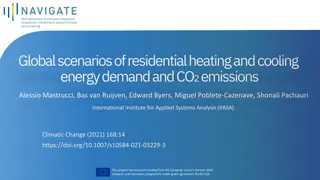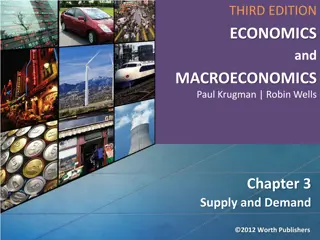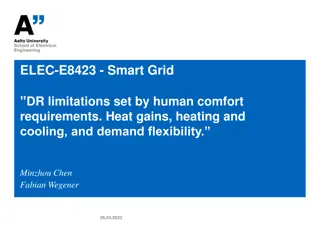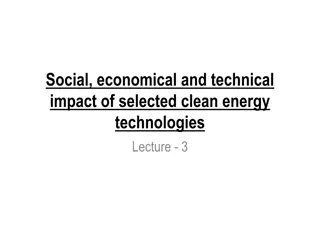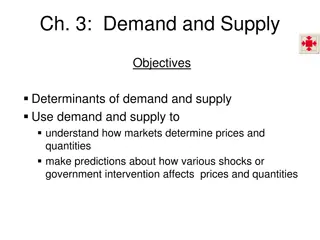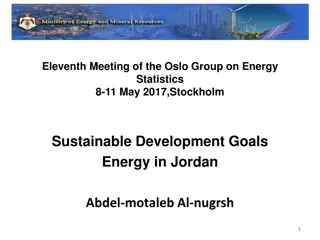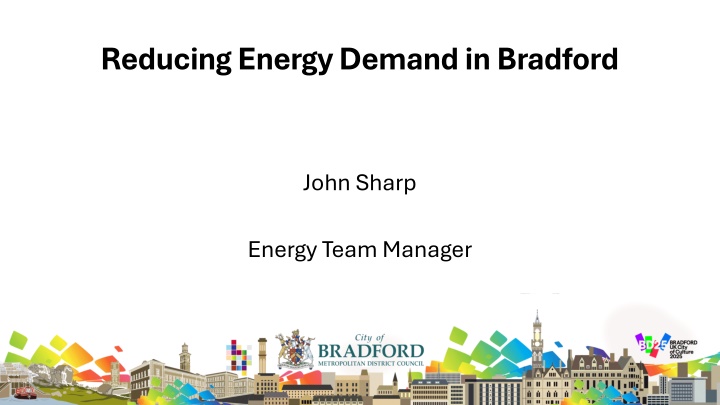
Reducing Energy Demand in Bradford: Approach, Actions, and Impacts
Introduction to a comprehensive energy reduction initiative led by John Sharp, Energy Team Manager in Bradford. The project focuses on reducing energy demand across a wide range of buildings and facilities, involving a structured approach, strategic actions, and measurable impacts. The team's composition, activities, targets, and key principles are highlighted to achieve the goal of net-zero carbon emissions by 2038.
Download Presentation

Please find below an Image/Link to download the presentation.
The content on the website is provided AS IS for your information and personal use only. It may not be sold, licensed, or shared on other websites without obtaining consent from the author. If you encounter any issues during the download, it is possible that the publisher has removed the file from their server.
You are allowed to download the files provided on this website for personal or commercial use, subject to the condition that they are used lawfully. All files are the property of their respective owners.
The content on the website is provided AS IS for your information and personal use only. It may not be sold, licensed, or shared on other websites without obtaining consent from the author.
E N D
Presentation Transcript
Reducing Energy Demand in Bradford John Sharp Energy Team Manager
Approach, Actions and Impacts Introduction Structure and team Approach Actions Impacts Challenges Next steps
Introduction 150 Main buildings Influence 200 schools Hundreds of sports pavilions, small buildings and pieces of land BMDC has over 8,000 employees Wide variety of building types High level of listed and thermally inefficient buildings Disposal plan to bring in capital receipts
Structure and Energy Team Dept of Corporate Resources Sustainability Team Highways Fleet Sports and Leisure Public Health Asset Management Finance Engineers Electricians Architects Surveyors Estates Management Built Environment Energy Team Manager Technical Intelligence and Performance Management Officer Sustainable Housing Officer Environment and Energy Officer Carbon Reduction officer x2 Energy Management officer x2 Utilities Billing Management Officer x2
Energy Team Activities Target Target net net- -zero carbon by 2038 zero carbon by 2038 10% CO2 emission reductions pa pa Energy management BMDC buildings and estate Carbon reduction EPCs, DECs Utilities contracts and billing Provision of data Domestic housing retrofit LAD3, ECO4, ECO-Flex, GBIS, new UK government warm homes projects and Pilot programmes Renewable energy projects Electric vehicle charging points 10% CO2 emission reductions
Approach Main Principles The lowest carbon kwh is the one you never use The lowest carbon kwh is the one you never use The cheapest kwh is the one you don t use The cheapest kwh is the one you don t use
Approach -plans and people Plans Plans Heating plan signed off by council executive sets parameters Sustainable Design Guide must be adhered to in all new projects Small projects budget of 500k plus each year People People Energy Team Staff, Built Environment Colleagues and other departments understand and use capabilities, experience/expertise Customers listen to, act on issues, educate and inform Psychology of heating
Approach data and control Data Data Monthly updates gas and electricity - overall and individual building Monitor, identify issues, measure impacts of changes Building Energy Management Systems Building Energy Management Systems 100 of our main buildings 100 of our main buildings - Real time monitoring of temperatures in buildings reporting over a period of time Able to optimise heating and lighting plans for each building Replicate and measure impacts of potential solutions
Approach Technology and Industry Technology Technology Work closely with companies (many local) to identify, test and trial solutions Be open to staff bringing in potential solutions Be open to companies bringing in potential solutions Look for low cost high impact solutions that can be rolled out across estate value for money Be prepared to make mistakes
Approach Best practice Internal find out from teams what has been tried in the past - build on success if it worked in the past - use it again External regular communications with other councils, public sector organisations, trade bodies (REA), private sector, companies and individuals APSE annual event (very good) presentations and peer discussions APSE informal dinners, regional events and internal expertise Only useful if you do something with the knowledge
Actions -impacts Optimised heating/lighting plan for each building Sensors (movement, heat, noise, CO2) sports halls 40% reduction Selective lighting controls sports pitches 30-50% reduction Radiator additive (Delta-T) - 10 to 30% reduction in gas usage Smart electric motors for air handling units 35% reduction Controllable LED lighting lighting levels set by specific areas 3- 4 year paybacks better lighting conditions for individuals
Impacts Gas usage Since peak in 2019/20 reduction of 18.5% Since 2021/22 reduction of 13.1% Gas Usage Comparison Gas Usage Comparison 40,000,000 35,000,000 30,000,000 25,000,000 20,000,000 15,000,000 10,000,000 5,000,000 - 2018/19 2019/20 2020/21 2021/22 2022/23 2023/24
Impacts Electricity usage Since peak in 2019/20 reduction of 15.0% Since 2021/22 reduction of 11.1% Electricity Usage Comparison 15,500,000 15,000,000 14,500,000 14,000,000 13,500,000 13,000,000 12,500,000 12,000,000 11,500,000 11,000,000 2018/19 2019/20 2020/21 2021/22 2022/23 2023/24
Impacts CO2 Emissions Scopes 1 and 2 plus small number of easily measurable scope 3s 2018/19 47,446 tonnes CO2e 2022/23 21,432 tonnes CO2e 55% CO2 emission reduction in last 5 years
Domestic Retrofit Programmes LAD 3, ECO 4, ECO Flex, GBIS, new UK government Warm Homes and pilot projects Solutions based on technology and approaches we know works and that the local supply chain can deliver at scale Fabric first approach not only improves thermal efficiency but also enhances the experience of living in the property Pilot project with WYCA using practical experience of solutions we have tried in BMDC estate and replicating in domestic homes
Domestic Retrofit Programmes Aim is to have cost effective solutions that reduce energy usage, increase deployment of renewable energy (solar PV) and improve comfort levels and living conditions for users Solutions include internal insulation, draught proofing, low temperature fan assisted radiators, building energy management systems, smart TRVs, smart air bricks, radiator additives and low carbon hot water Prepare buildings for the next stage of deployment of renewable and low carbon heating options heat network or heat pumps
Challenges Public sector processes including IT, procurement and legal Silo approach Early comprehensive engagement on projects Lack of joined up thinking with strategies/plans linking to objectives Poorly designed and delivered projects value engineering? Budgets Funding applications Lack of sharing of knowledge and best practice
What next Further optimisation of heating and lighting plans Continued deployment of BEMS, smart sensors and radiator additives Vortex kit for wet heating systems in trial phase Ceramic micro-filtration systems for pools due 2025 30-40% Solar PV solar farms and buildings gradual deployment District Heat Network contract negotiation HyBradford advanced fuel facility Co-ordinated estates and energy strategies/plans with BMDC plans
Thank you John Sharp John.sharp@bradford.gov.uk




